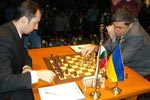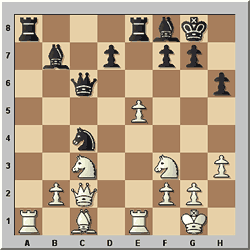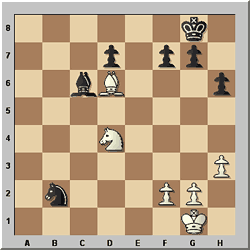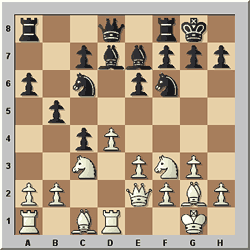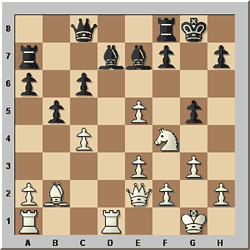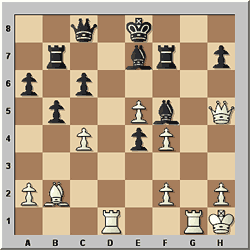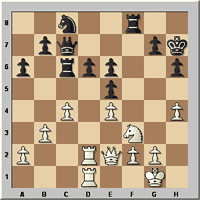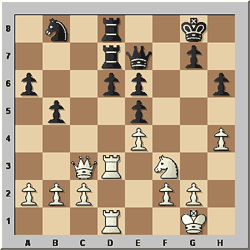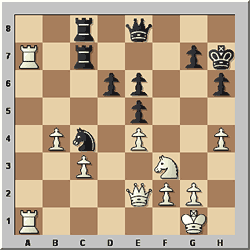
Round two
Round 2: Sunday, February 18th |
Peter Leko |
½-½ |
Alex. Morozevich |
Levon Aronian |
½-½ |
Magnus Carlsen |
Vishy Anand |
½-½ |
Peter Svidler |
Vassily Ivanchuk |
1-0 |
Veselin Topalov |
|
|
Round 3: Monday, February 19th |
Veselin Topalov |
|
Peter Leko |
Peter Svidler |
|
Vassily Ivanchuk |
Magnus Carlsen |
|
Vishy Anand |
Alex. Morozevich |
|
Levon Aronian |
Games – Report |
|
Standings after two rounds
Commentary by GM Mihail Marin
The following express commentary was provided by Romanian GM Mihail Marin,
who is the author of a number of very popular ChessBase training CDs and articles
for ChessBase Magazine. GM Marin will study the games of the Morelia/Linares
tournament in greater detail and provide the full results of his analysis in
the next issue of ChessBase
Magazine.
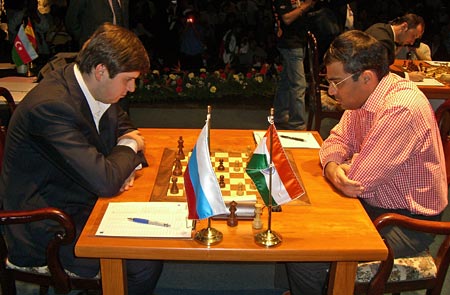
Peter Svidler vs Vishy Anand in round two
Anand,V (2779) - Svidler,P (2728) [C88]
XXIV SuperGM Morelia/Linares MEX/ESP (2), 18.02.2007 [Mihail Marin]
1.e4 e5 2.Nf3 Nc6 3.Bb5 a6 4.Ba4 Nf6 5.0-0 Be7 6.Re1 b5 7.Bb3 0-0 8.h3.
Svidler is not given the possibility of continuing the theoretical discussion
in the Marshall from the previous round, where he had been sitting on the other
side of the board against Aronian. 8...Bb7 9.d3 Re8 10.a4 h6 11.Nbd2 Bf8
12.c3 Na5 13.Bc2 c5 14.d4. White decides to play this move with loss of
time, probably relying on the fact that Black has not played ...d6 yet, which
could cause him problems maintaining his stability in the centre. The next phase
of the game will not justify his approach. 14...cxd4 15.cxd4 exd4 16.e5 Nd5
17.Nxd4 Nb4 18.axb5 Nxc2 19.Qxc2 axb5 20.Nxb5 Qb6 21.Nc3 Qc6 22.Nf3 Nc4.
Black's excellent development and his mighty light-squared bishop offer him entirely
satisfactory compensation for the pawn.
23.Rxa8 Bxa8 24.Bf4 Bb4 25.Qb3 Ba5
26.Rc1 Qe6 27.Ne1 Bc6 28.Ne2 Nxe5 29.Qxe6 Rxe6 After winning the pawn back,
Black has the better chanecs already, due to his strong pair of bishops.
30.Nd4
Bxe1 31.Rxe1 Nd3 32.Nxe6 Nxe1 33.Nd4 Nd3 34.Bd6 Nxb2.
Things have calmed down now. Black's extra-pawn does not have too much significance
because of the presence of opposite-coloured bishops. 35.f3 Nc4 36.Bb4 h5
37.Kf2 f6 38.Nf5 Ne5 39.Bc3 Kf7 40.Nd6+ Ke7 41.Nf5+ Kf8 42.Ke3 g6 43.Nd6 Ke7
44.Bb4 g5 45.Nc4+ Ke6 46.Nxe5 fxe5 47.Bd2 1/2-1/2. [Click
to replay]
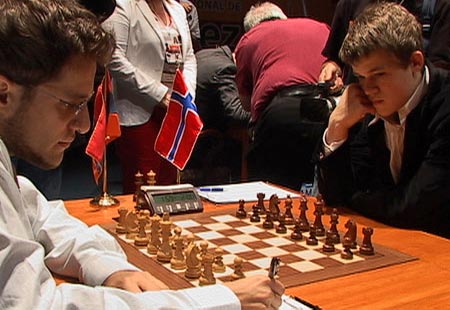
Levon Aronian vs Magnus Carlsen
Aronian,L (2744) - Carlsen,M (2690) [E04]
XXIV SuperGM Morelia/Linares MEX/ESP (2), 18.02.2007 [Mihail Marin]
1.d4 Nf6 2.c4 e6 3.g3. Such important events as the World Championship
match from Elista usually determine changes in the fashion. Aronian has included
the Catalan in his repertoire recently; in Wijk aan Zee he obtained two important
wins with it. 3...d5 4.Nf3 dxc4 5.Bg2 a6 6.0-0 Nc6 7.e3 Bd7 8.Qe2 b5 9.Rd1
Be7 10.Nc3 0-0.
A courageous novelty. Black decides to ignore the pin along the Catalan diagonal.
11.Ne5 Qe8 Black has managed to prevent the immediate threats, but his
coordination is rather poor, at least temporarily.
12.b3. White decides
to undermine Black's advantage of space on the queenside. A more natural continuation
was 12.e4 , aiming to continue the development, for instance 12...Rd8 13.Be3 Bc8
14.f4]
12...Nd5 [Black considered the opening of the a-file with 12...cxb3
13.axb3 to be too dangerous. Instead, he prefers to return his small material
advantage in order to activate his play.
13.Bxd5. Giving up the Catalan
bishop in order to install a second active knight in the centre.
13...exd5
14.Nxd5 Nxe5 15.dxe5 Ra7 16.bxc4 White is a pawn up already, but the weakness
of the light squares offer Black good compensation.
16...c6 17.Nf4 Qc8 18.Bb2
g5.
19.e4!? An interesting decision. White could not find a stable square for
his knight too easily and decides to sacrifice it in the hope of obtaining a direct
attack against the king. The plan is logical from asbtract point of view, but
probably unsound practically.
19...gxf4 20.gxf4 f5 21.Qe3 Rb7 22.Qg3+ Kf7 23.Qh3
Ke8 24.Qh5+ Rf7 25.Kh1 fxe4 26.Rg1 Bf5 27.Rad1.
27...Rd7. Probably missing White's answer. After 27...Bg6 , the attack
would have been difficult to carry out. 28.e6! Bxe6 29.Rg8+ Bf8 30.Rxf8+!
A draw by perpetual is inevitable now. 30...Kxf8 31.Qh6+ Ke7 1/2-1/2.
[Click to replay]
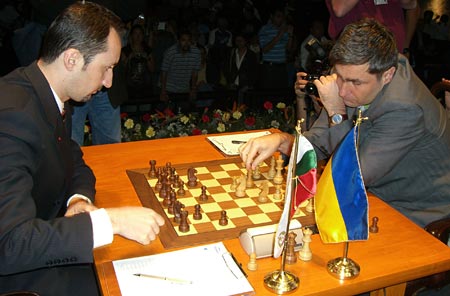
Veselin Topalov vs Vassily Ivanchuk in round two
Ivanchuk,V (2750) - Topalov,V (2783) [B90]
XXIV SuperGM Morelia/Linares MEX/ESP (2), 18.02.2007 [Mihail Marin]
1.e4 c5 2.Nf3 d6 3.d4 cxd4 4.Nxd4 Nf6 5.Nc3 a6 6.Be3 e5. Although
Topalov has obtained outstanding results with 6...e6 over the past years, the
text move is also part of his main repertoire. 7.Nf3!? Nowadays, the
main theoretical discussion is held in the sharp lines starting with 7.Nb3 .
The knight retreat to f3, which became popular in the '80s, mainly as a consequence
of the efforts of the leading English Grandmasters, usually leads to a positional
battle. It might seem that the knight is less favourably placed on f3, by blocking
the f-pawn and failing to put pressure on the enemy queenside, but the situation
is not that onesided. 7...Be7. One of the most obvious ideas of 7.Nf3
is that it inhibits 7...Be6 , which can be met by 8.Ng5 . 7...h6 and 7...Qc7
are the main alternatives to the text move. 8.Bc4. Now, we can notice
a further difference, if compared to the lines based on 7.Nb3. If attacked with
...Qc7 or ...b5, the bishop can safely retreat to b3, in the spirit of the Sozin
Attack, but with the significant difference that the a2-g8 diagonal has been
weakened after the early advance of the black e-pawn. 8...0-0 9.0-0 Be6.
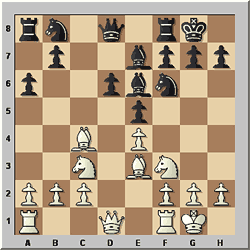
10.Bxe6!? This apparently simplistic move has never been played at grandmaster
level. Apparently, White is just helping his opponent to strengthen his centre,
but Ivanchuk relied on some hidden dynamic factors. There have been some recent
development after 10.Bb3 . The following game, one of Leko's first experiences
ever as a Najdorf player with Black, must have inspired Ivanchuk when choosing
the structure in the centre: 10...Nc6
(It should be mentioned that the
only game where Topalov faced 7.Nf3 continued with
10...b5 , but Black
failed to equalize, Kramnik-Topalov, Cap d'Agde 2003.
) 11.Bg5 Nd7 12.Bxe7
Qxe7 13.Nd5 Qd8 14.c3 Na5 15.Re1 Rc8 16.h3 Nb6
(Later, Leko took greater
care about the activity of hisknight and gradually equalized after
16...b5
17.Nh2 Nc4 in Svidler-Leko, Morelia/Linares 2006.
) 17.Nxb6 Qxb6 18.Bxe6
fxe6 19.Re2 Rc6 20.Qd3 Qc7 21.Rd1 Nc4 22.b3 Nb6 23.c4 Nc8 24.Red2 h6 25.Qe2 Kh7
26.h4 White was clearly better and went on winning in Anand-Leko, Wijk aan Zee
2006.
We can see that the situation is very similar to that arising after White's 22nd
move in our main game. The d6-pawn is submitted to strong pressure, the black
knight cannot find a good square, while the white h-pawn keeps Black's eventual
kingside counterplay under control.]
10...fxe6 11.Na4 White's idea becomes
clear now. The weakness of the b6- and e6-squares cause Black serious problems
with finishing his development. The generally desirable 11...Nbd7 is impossible
because of 12.Ng5.
11...Ng4 This solves the problem only partially. In
fact, it just helps White complete his development.
12.Qd3 Nxe3 13.Qxe3. Apart
from Nb6, White has a new threat already: Qb3, with attack against b7 and e6.
13...b5 14.Nb6 Ra7 15.Nd5 Rb7 16.Qd2. Maintaining the knight in the centre
for as long as possible, in order to prevent the harmonious development of Black's
pieces.
16...Nc6 17.Rad1 Rd7 18.Qc3 Nb8 19.Nxe7+. Now that the enemy knight
has retreated to a passive square, this exchange is entirely justified.
19...Qxe7
20.Rd3 h6 21.Rfd1 Rfd8 22.h4.
Dr. Tarrasch used to say: If one piece stands badly, the whole position is bad.
This applies here perfectly. With his knight on a favourable square (such as f7
or f6, Black would have a dream position, because of his strong control over the
centre. However, it is virtually impossible to activate the knight, which leaves
him struggling.
22...Kh7 23.R1d2 Qf8 24.Qb3 Qe8 25.a4 Qg6!? [Topalov decides
to give up a pawn in order to finally bring his knight into play. In case of 25...bxa4
26.Qxa4 White would have had several plans at his disposal, for instance the infiltration
through the b-file or the creation of a passed b-pawn.]
26.axb5 axb5 27.Re3
Na6 28.Qxb5 Nc5 29.Qc4 Ra7 30.Re1 Qe8 31.b4 Na4 32.Qb3 Nb6 33.Red1 Rad7 34.Qd3
Rc8 35.c3 Ra7 36.Qe3 Ra6 37.Qe2 Nc4 38.Ra2 Rac6 39.Ra7 R6c7 40.Rda1
Topalov's plan has succeeded only partially. His knight has reached a stable
square, but White is under no direct pressure and can hope to gradually convert
his extra-pawn into a win. 40...Qf7?? A relatively convincing proof that
the recent accusations against Topalov do not have a solid basis. 41.Qxc4.
If 41...Rxa7, then 42.Rxa7, retaining an extra-knight. 1-0. [Click
to replay]

Alexander Morozevich vs Peter Leko
Leko,P (2749) - Morozevich,A (2741) [C12]
XXIV SuperGM Morelia/Linares MEX/ESP (2), 18.02.2007 [Mihail Marin]
1.e4 e6 2.d4 d5 3.Nc3 Nf6 4.Bg5 Bb4. The old Mac Cutcheon variation.
Nowadays, the more solid 4...Be7 ; and 4...dxe4 are by far more popular, but,
as usual, Morozevich aims for a complicated fight. 5.e5 h6 6.Bd2 Bxc3 7.bxc3
Ne4 8.Qg4 g6 9.Bd3 Nxd2 10.Kxd2 c5 11.h4 Qa5 12.Nf3 Nd7 13.Rhb1 cxd4 14.Qxd4.
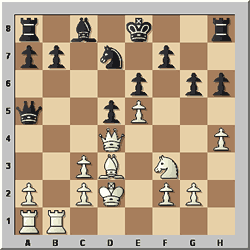
From structural point of view, the opening has been quite a success for Black.
However, his considerable delay in development and the difficulties in finding
a safe place for the king make the position difficult to judge. 14...a6 15.Rb4
Qc7 16.c4 a5. In order to avoid the immediate activation of the rook along
the c-file (...dxc4 Rxc4), Black creates a small weakness in his camp (b5).
17.Rb3 dxc4 18.Qxc4 Nc5! A highly instructive moment. It might seem
as if Black should be interested in trading queens, in order to solve his aforementioned
problems. However, after 18...Qxc4? 19.Bxc4 he could not reach the desired stability
on dark squares with 19...Nc5 because of 20.Rb5 . As we shall see, the black
queen is needed precisely to defend the b6- and c5-squares. 19.Rc3.
19.Rb5? is inefficient now because of 19...b6 , threatening ...Ba6. 19...b6
20.Qf4 Bb7.
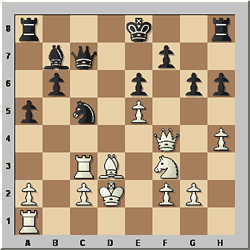
Black has almost completed his development, without making any major concession.
He "only" needs to bring his king into safety now. 21.Nd4 Qd8 22.f3
g5!? Morozevich' plans start getting contour. He plans to leave the king
in the centre in order to increase his influence on dark squares on the wings.
23.Qe3 Leko prevents the opening of the h-file for the black rook, but
after Black's next move the g-file will prove just as good. 23...gxh4 24.Nb5
Kf8 25.Nd6 Bd5 26.Rb1 Qg5 27.Bf1 Qxe3+ 28.Rxe3 Rb8 29.Bc4 Rg8.
Black's plan has been crowned with success. White does not have any chances
for advantage. 30.Re2 Bxc4 31.Nxc4 h3 32.gxh3 Rg3 33.Ke3 Na4 34.Kf4 Rg5 35.Rb3
Ke7 36.h4 Rf5+ 37.Kg3 Rg8+ 38.Kf2 Rf4 39.Nxb6 Rxh4 40.Nxa4 Rxa4 41.Rb7+ 1/2-1/2.
[Click to replay]
Videos
Schedule and results
Round 1: Saturday, February 17th |
| Vassily Ivanchuk |
½-½ |
Peter Leko |
Veselin Topalov |
½-½ |
Vishy Anand |
Peter Svidler |
½-½ |
Levon Aronian |
Magnus Carlsen |
1-0 |
Alex. Morozevich |
|
|
Round 2: Sunday, February 18th |
Peter Leko |
½-½ |
Alex. Morozevich |
Levon Aronian |
½-½ |
Magnus Carlsen |
Vishy Anand |
½-½ |
Peter Svidler |
Vassily Ivanchuk |
1-0 |
Veselin Topalov |
|
|
Round 3: Monday, February 19th |
Veselin Topalov |
|
Peter Leko |
Peter Svidler |
|
Vassily Ivanchuk |
Magnus Carlsen |
|
Vishy Anand |
Alex. Morozevich |
|
Levon Aronian |
Games – Report |
|
|
Free day: Tuesday, February 20th |
|
Round 4: Wednesday, February 21st |
Peter Leko |
|
Levon Aronian |
Vishy Anand |
|
Alex. Morozevich |
Vassily Ivanchuk |
|
Magnus Carlsen |
Veselin Topalov |
|
Peter Svidler |
Games – Report |
|
Round 5: Thursday, February 22nd |
Peter Svidler |
|
Peter Leko |
Magnus Carlsen |
|
Veselin Topalov |
Alex. Morozevich |
|
Vassily Ivanchuk |
Levon Aronian |
|
Vishy Anand |
Games – Report |
|
|
Free day: Friday, February 23rd |
|
Round 6: Saturday, February 24th |
Magnus Carlsen |
|
Peter Leko |
Alex. Morozevich |
|
Peter Svidler |
Levon Aronian |
|
Veselin Topalov |
Vishy Anand |
|
Vassily Ivanchuk |
Games – Report |
|
Round 7: Sunday, February 25th |
| Peter Leko |
|
Vishy Anand |
Vassily Ivanchuk |
|
Levon Aronian |
Veselin Topalov |
|
Alex. Morozevich |
Peter Svidler |
|
Magnus Carlsen |
Games – Report |
|
|
Transfer to Linares, Spain |
|
Links
